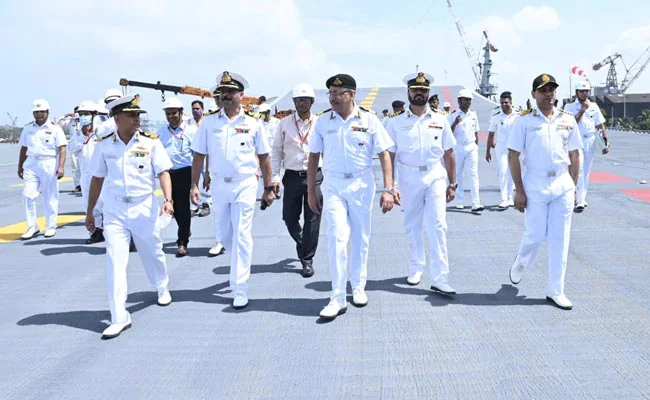Aircraft carrier ins vikrant: The Indian Navy on Thursday took delivery of the indigenous aircraft carrier ‘Vikrant’ from the Cochin Shipyard Limited (CSL) in Kochi.
India’s First Indigenous Aircraft Carrier
“Indian Navy has created maritime history today by taking delivery of the iconic indigenous Aircraft Carrier (AC) ‘Vikrant’ from its builder Cochin Shipyard Limited (CSL), Kochi. Designed by the Indian Navy’s in-house Directorate of Naval Design (DND) and built by CSL, a public sector shipyard under the Ministry of Shipping (MoS), the carrier is named after its illustrious predecessor, India’s first aircraft carrier Gaya, which played an important role in the 1971 war. India’s independence ‘Azadi Ka Amrit Mahotsav’, the rebirth of Vikrant, is a true testament to the country’s zeal and enthusiasm for capacity building towards enhancing maritime security,” the Indian Navy said.
Aircraft Carrier ‘Vikrant’
The 262-metre-long carrier has a full displacement of around 45,000 tonnes which is much larger and more advanced than its predecessor.
The ship is powered by four gas turbines with a total power of 88 MW and a maximum speed of 28 knots. Constructed at a total cost of around ₹20,000 crore, the project has been proceeded in three phases of contract between MoD and CSL, which were concluded in May 2007, December 2014 and October 2019 respectively. The ship’s keel was laid in February 2009, followed by a launch in August 2013.
With an overall indigenous content of 76 per cent, the IAC is a perfect example of the country’s quest for “Self-reliant India” and underpins the government’s ‘Make in India’ initiative. With the delivery of Vikrant, India joins a select group of countries that have the capability to design and manufacture aircraft carriers indigenously.
india’s first aircraft carrier ins vikrant
The Vikrant is built with a high degree of automation for machinery operation, ship navigation and survivability, and is designed to accommodate an assortment of fixed-wing and rotary aircraft. The ship will be capable of operating an air wing consisting of 30 aircraft consisting of indigenously built Advanced Light Helicopters (ALH) and light combat aircraft besides MIG-29K fighter jets, Kamov-31, MH-60R multi-role helicopters. LCA) (Navy). Using a novel avionics mode known as STOBAR (Short Take-Off but Arrested Landing), the IAC ski-jumps to launch aircraft and a series of ‘arrest wires’ for their retrieval onboard. The set is equipped with.
The ship is equipped with a large number of indigenous equipment and machinery, which includes major industrial houses of the country. More than 100 MSMEs along with BEL, BHEL, GRSE, Keltron, Kirloskar, Larsen & Toubro, Wartsila India etc. Indigenization efforts, apart from the development of ancillary industries, have led to the creation of employment opportunities and the hull back effect on the economy at local as well as pan-India level. One of its major spin-offs is the development and production of indigenous warship-grade steel for ships through a partnership between the Navy, DRDO and the Steel Authority of India (SAIL), which has enabled the country to become self-reliant with dignity. For battleship steel. The Navy said that all the warships being built in the country today are being constructed from indigenous steel.
vikrant aircraft carrier status
Several design iterations, including the use of 3D virtual reality models and advanced engineering software, were used by the Naval Design Directorate in shaping the design of the carrier. CSL had upgraded its shipbuilding infrastructure as well as productivity skills during the construction of the ship.
The delivery of Vikrant was marked by the signing of acceptance documents by Vikrant’s Designated Commanding Officer, representatives of Naval Headquarters and Warship Maintenance Team (Kochi) on behalf of the Indian Navy and the Chairman and Managing Director on behalf of Cochin Shipyard Limited. In the presence of senior officials of the Indian Navy and Cochin Shipyard.
Vikrant has been delivered to the Indian Navy by CSL after extensive user acceptance trials conducted between August 2021 and July 2022, during which the ship’s performance, including rudder, main propulsion, PGD, accessories, aviation facilities, weapons and sensors As well as marine maintenance. And the maneuverability proved to be satisfactory according to the test protocol and system parameters.
The delivery of Vikrant today is the culmination of a long design, build and test phase during which both the Indian Navy and CSL had to overcome several unprecedented technical and logistical challenges including the COVID-19 pandemic and the changed geopolitical scenario.
The Navy claims that the successful delivery of the indigenous carrier, a major milestone activity and historic event, is a testimony to the dedicated efforts of a large number of stakeholders within the Indian Navy, Shipyards, Industry, OEMs and MSMEs.
The indigenous aircraft carrier will soon be inducted into the Indian Navy as the Indian Naval Ship (INS) Vikrant which will boost India’s position in the Indian Ocean Region (IOR) and its quest for a blue water navy.













